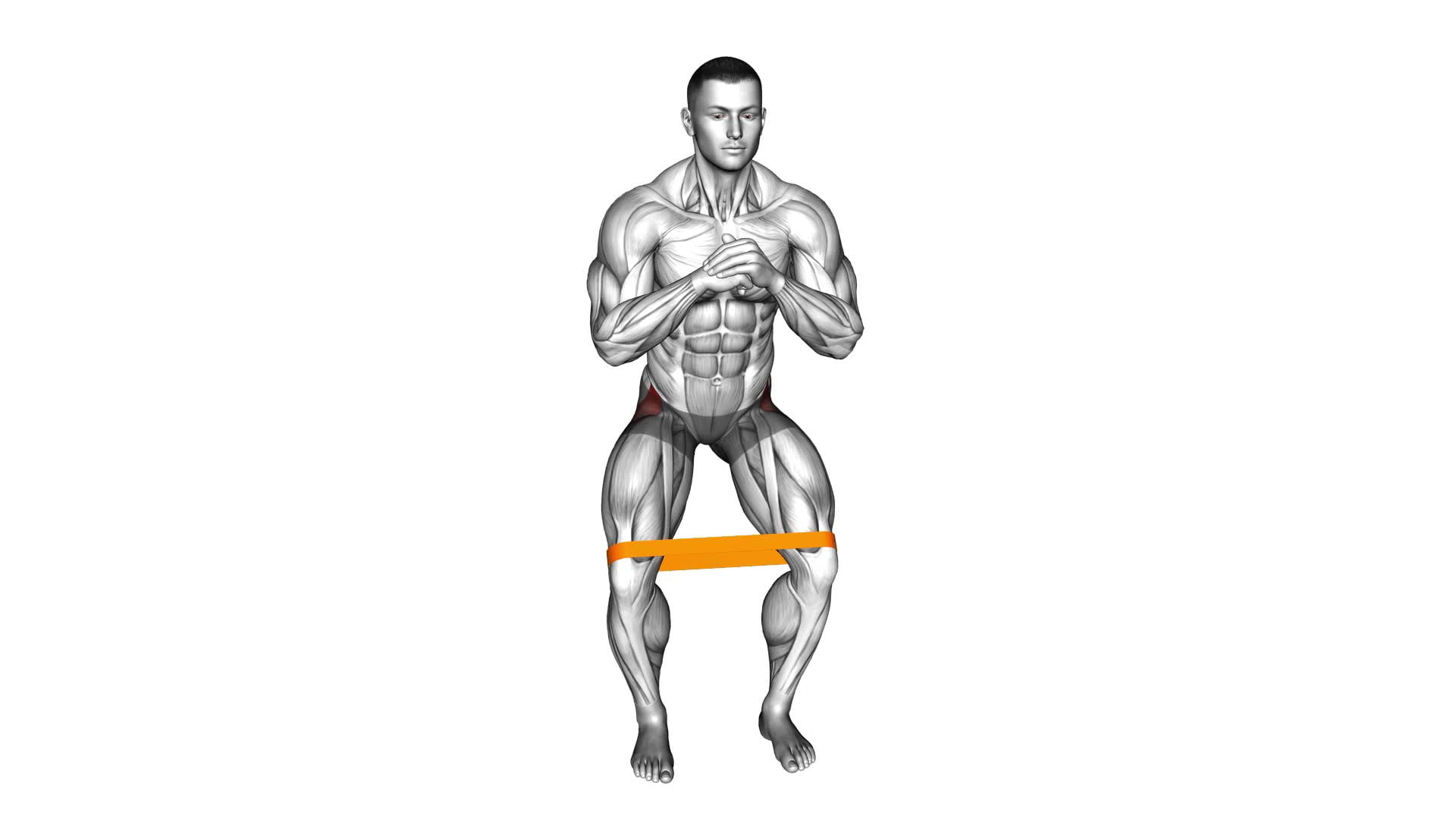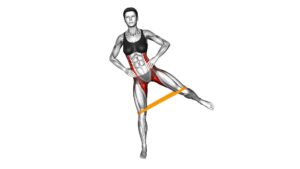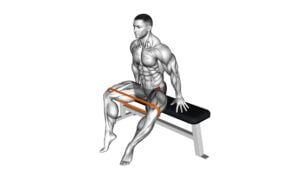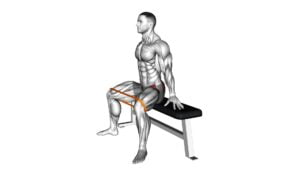Resistance Band Standing Hip Abduction – Video Exercise Guide & Tips

Get ready to tone and strengthen your hips with the Resistance Band Standing Hip Abduction exercise. In this video exercise guide, you'll learn proper form, technique, and tips for a successful workout.
Watch This Exercise Video
Discover the benefits of this exercise, choose the right resistance band, and avoid common mistakes.
With variations and progressions to challenge yourself, you'll be on your way to a stronger lower body.
Let's get started!
Key Takeaways
- Resistance band standing hip abduction increases flexibility, prevents injuries, improves range of motion in hips, and strengthens hip abductor muscles.
- Proper form and technique, such as maintaining proper hip alignment, engaging core muscles for stability, and avoiding excessive momentum or leaning forward, are important for optimal results.
- Keeping feet parallel, standing tall with feet shoulder-width apart, activating core muscles, and maintaining level hips and a straight line from head to feet are key tips for hip alignment.
- Core engagement is crucial as it stabilizes the spine and pelvis, prevents unnecessary movement or compensation, provides a stable base for movements, and protects the lower back from strain or injury.
Benefits of Resistance Band Standing Hip Abduction
You can experience numerous benefits by incorporating resistance band standing hip abduction into your workout routine. This exercise is highly effective in increasing flexibility and preventing injuries. By performing resistance band standing hip abduction, you can improve the range of motion in your hips and strengthen the muscles in your hip abductors.
This increased flexibility can have a positive impact on your overall athletic performance and daily activities. Additionally, by strengthening these muscles, you can help prevent common injuries such as hip strains and sprains.
The resistance provided by the band adds an extra challenge to the exercise, making it more effective in targeting and toning the specific muscles involved. By regularly including resistance band standing hip abduction in your workout routine, you can see improved flexibility, reduced risk of injury, and enhanced muscle strength.
Moving on to the subsequent section about proper form and technique, it's important to ensure that you're performing this exercise correctly to maximize its benefits.
Proper Form and Technique
To perform the Resistance Band Standing Hip Abduction exercise with proper form and technique, there are a few key points to keep in mind.
First, focus on maintaining proper hip alignment throughout the movement to avoid any unnecessary strain on the joints.
Second, engage your core muscles to stabilize your body and maintain balance.
Lastly, be mindful of common mistakes such as using excessive momentum or leaning your upper body forward, and make sure to avoid them for optimal results.
Hip Alignment Tips
Maintain proper alignment of your hips throughout the Resistance Band Standing Hip Abduction exercise by engaging your core and keeping your feet parallel to each other. This is important for effective hip strengthening and improving hip mobility.
To ensure proper alignment, start by standing tall with your feet shoulder-width apart. Activate your core by drawing your belly button towards your spine.
As you lift your leg out to the side with the resistance band, focus on keeping your hips level and avoiding any tilting or twisting. Imagine a straight line running from your head to your feet, and keep your shoulders relaxed.
This alignment will help target the hip muscles effectively and prevent any unnecessary strain or injury.
Core Engagement Importance
Properly engaging your core is essential for maintaining proper form and technique during the Resistance Band Standing Hip Abduction exercise.
Core activation plays a crucial role in stability training, as it helps to stabilize your spine and pelvis, preventing any unnecessary movement or compensation.
When performing the standing hip abduction exercise, focus on drawing your belly button towards your spine to engage your deep core muscles. This will provide a stable base for your movements and enhance the effectiveness of the exercise.
Additionally, maintaining a strong and engaged core will help protect your lower back from any strain or injury.
Remember to breathe deeply and maintain core engagement throughout the exercise for optimal results.
Common Mistakes to Avoid
Ensure Correct Form and Technique for Resistance Band Standing Hip Abduction to maximize effectiveness and prevent injury.
To avoid injury and maximize results, here are some common mistakes to avoid:
- Using too much tension: Start with a lighter resistance band and gradually increase the tension as you become more comfortable with the exercise.
- Leaning forward or backward: Maintain an upright posture throughout the exercise to target the hip muscles effectively.
- Allowing the knees to collapse inward: Keep your knees in line with your toes to prevent unnecessary strain on the knees.
- Using momentum: Perform the movement slowly and with control, focusing on squeezing the hip muscles at the top of the movement.
- Neglecting the core: Engage your core muscles to stabilize your body and maintain proper alignment.
By avoiding these common mistakes, you can ensure proper form and technique, minimizing the risk of injury and maximizing the effectiveness of the resistance band standing hip abduction exercise.
Now, let's move on to the next section about choosing the right resistance band.
Choosing the Right Resistance Band
Selecting the appropriate resistance band is crucial for optimizing your standing hip abduction workout. When it comes to resistance band exercises, choosing the right band can make all the difference in achieving your fitness goals. The first thing to consider when selecting a resistance band is the level of resistance it provides. Bands come in different colors or levels of resistance, ranging from light to heavy. It's important to choose a band that challenges your muscles without causing strain or discomfort.
Another factor to consider is the length of the band. Resistance bands come in various lengths, and the length you choose will depend on the exercises you plan to perform. Longer bands are ideal for exercises that require more range of motion, while shorter bands are better suited for exercises that focus on isolated muscle groups.
Additionally, the material of the resistance band should be taken into account. Bands are typically made of either latex or fabric. Latex bands provide more resistance and are more durable, while fabric bands offer a softer feel and are more comfortable on the skin.
Finally, it's important to consider your own fitness level and goals when selecting a resistance band. If you're a beginner or have limited strength, starting with a lighter resistance band is recommended. As you progress, you can gradually increase the resistance to challenge your muscles further.
Common Mistakes to Avoid
When performing standing hip abduction with a resistance band, it's important to be aware of common mistakes that can hinder your progress and potentially lead to injury. To ensure a safe and effective workout, here are some common mistakes to avoid:
- Using too much tension: Avoid using a resistance band that's too tight, as this can strain your muscles and increase the risk of injury. Start with a lighter band and gradually increase the tension as your strength improves.
- Relying solely on momentum: It's crucial to perform the exercise with control and focus. Avoid swinging your leg outward using momentum, as this can decrease the effectiveness of the exercise and put unnecessary strain on your joints.
- Not maintaining proper form: Keep your core engaged, maintain a neutral spine, and avoid leaning or tilting your body during the movement. This will help to target the correct muscles and prevent strain on other areas of your body.
- Neglecting modifications and adaptations: If you have any pre-existing injuries or limitations, it's important to modify the exercise accordingly. Consult with a fitness professional or physical therapist to find the appropriate modifications or adaptations for your specific needs.
- Overtraining: While it's important to challenge yourself, overtraining can lead to fatigue, muscle imbalances, and increased risk of injury. Allow your muscles time to recover and listen to your body's signals to avoid overdoing it.
Variations and Progressions
Now let's explore different ways to increase the difficulty levels and target various muscle groups with the resistance band standing hip abduction exercise.
By incorporating variations and progressions, you can challenge your muscles in new ways and continue to make progress.
These variations may include using different resistance bands with varying levels of tension, changing the position of your feet or the angle of your leg, or even adding additional resistance with ankle weights or dumbbells.
Increasing Difficulty Levels
To progress your resistance band standing hip abduction exercise, incorporate variations and progressions into your routine. Here are some ways to increase the difficulty levels and challenge your muscles:
- Increase resistance: Use a band with higher tension to provide more resistance and intensify the exercise.
- Change foot position: Try standing on one leg while performing the hip abduction to engage your stabilizing muscles and improve balance.
- Add pulses: After lifting your leg to the side, hold for a second and then perform small pulses up and down to further activate your hip muscles.
- Use ankle weights: Attach ankle weights to your leg for added resistance and a greater challenge.
- Incorporate other exercises: Combine the standing hip abduction with other lower body exercises, such as squats or lunges, to target multiple muscle groups and create a more comprehensive workout.
By incorporating these progression levels and modifications, you can continue challenging yourself and achieving greater results in your resistance band standing hip abduction exercise.
Now, let's explore how to target different muscle groups.
Targeting Different Muscle Groups
To target different muscle groups and further enhance your resistance band standing hip abduction exercise, incorporate variations and progressions into your routine. By making exercise modifications, you can activate different muscles and challenge your body in new ways.
One variation is to perform the hip abduction exercise while standing on an unstable surface, such as a foam pad or balance board. This will engage your core muscles and improve your balance.
Another option is to increase the resistance of the band by using a thicker band or adding more bands. This will provide a greater challenge for your hip abductor muscles.
Additionally, you can add a pulsing motion at the top of the movement to increase the intensity and muscle activation.
Remember to always listen to your body and progress at your own pace.
Tips for a Successful Workout
Achieving success in your workout requires discipline, consistency, and determination. To maximize the effectiveness of your workout routine, here are some tips to keep in mind:
- Proper Warm Up: Always start your workout with a proper warm-up session. This helps increase blood flow to the muscles, improve flexibility, and reduce the risk of injury.
- Set Realistic Goals: Set achievable goals for yourself to stay motivated and focused during your workout. Start with small milestones and gradually increase the intensity and duration of your exercises.
- Listen to Your Body: Pay attention to your body's signals. If you feel any pain or discomfort, modify or stop the exercise. Pushing yourself too hard can lead to injuries and setbacks.
- Rest and Recovery: Allow your body to rest and recover between workouts. Rest days are just as important as workout days. Giving your muscles time to repair and rebuild will enhance your overall performance.
- Stay Hydrated and Fuel Your Body: Drink plenty of water before, during, and after your workout to stay hydrated. Additionally, nourish your body with a balanced diet, including protein, carbohydrates, and healthy fats to support muscle growth and recovery.
Frequently Asked Questions
How Many Sets and Reps Should I Do for Resistance Band Standing Hip Abduction?
To perform resistance band standing hip abduction, you need to know the number of reps and the proper form. The number of reps will depend on your fitness level and goals. It's best to start with 2-3 sets of 10-12 reps and gradually increase as you get stronger.
Remember to maintain proper form by keeping your core engaged, standing tall, and using controlled movements. This exercise targets your hip muscles and can help improve hip stability and strength.
Can I Use Resistance Bands for Other Exercises Besides Hip Abduction?
Sure, you can definitely use resistance bands for other exercises besides hip abduction. Resistance bands are versatile and can be used for a variety of exercises such as bicep curls, shoulder presses, and squats.
They provide a different type of resistance compared to weights, which can help improve strength, stability, and flexibility. Incorporating resistance band exercises into your routine can add variety and challenge to your workouts, ultimately enhancing your overall fitness level.
How Long Should I Rest Between Sets During a Resistance Band Standing Hip Abduction Workout?
To get the most out of your resistance band standing hip abduction workout, it's important to know how long to rest between sets.
Rest duration can vary depending on your fitness level and goals. Generally, a rest period of 30-60 seconds is sufficient to allow for muscle recovery while still maintaining muscle activation.
This gives your muscles enough time to recover without losing the benefits of the exercise. Remember, listen to your body and adjust the rest duration as needed.
What Is the Difference Between Resistance Bands and Weights for Hip Abduction Exercises?
When comparing resistance bands and weights for hip abduction exercises, it's important to consider the benefits of each.
Resistance bands offer a different type of resistance that engages your muscles in a unique way. They also provide a more portable and versatile option for workouts.
On the other hand, weights allow for a greater range of resistance options and can help increase strength more quickly.
Ultimately, the choice between resistance bands and weights depends on your specific goals and preferences.
Can Resistance Band Standing Hip Abduction Help With Improving Balance and Stability?
Resistance band standing hip abduction can be beneficial for improving your balance and stability. This exercise specifically targets your hip muscles, which are important for maintaining stability and coordination.
Resistance band training has numerous benefits, such as increasing muscle strength and endurance. By incorporating resistance bands into your workout routine, you can enhance your overall balance and stability while reaping the benefits of resistance band training.
Conclusion
In conclusion, resistance band standing hip abduction is a highly effective exercise for strengthening the hip muscles. By using the proper form and technique, choosing the right resistance band, and avoiding common mistakes, you can maximize the benefits of this exercise.
Additionally, incorporating variations and progressions can challenge your muscles even further. Remember to follow these tips for a successful workout and enjoy the benefits of stronger hips.

Author
Years ago, the spark of my life’s passion ignited in my mind the moment I stepped into the local gym for the first time. The inaugural bead of perspiration, the initial endeavor, the very first surge of endorphins, and a sense of pride that washed over me post-workout marked the beginning of my deep-seated interest in strength sports, fitness, and sports nutrition. This very curiosity blossomed rapidly into a profound fascination, propelling me to earn a Master’s degree in Physical Education from the Academy of Physical Education in Krakow, followed by a Sports Manager diploma from the Jagiellonian University. My journey of growth led me to gain more specialized qualifications, such as being a certified personal trainer with a focus on sports dietetics, a lifeguard, and an instructor for wellness and corrective gymnastics. Theoretical knowledge paired seamlessly with practical experience, reinforcing my belief that the transformation of individuals under my guidance was also a reflection of my personal growth. This belief holds true even today. Each day, I strive to push the boundaries and explore new realms. These realms gently elevate me to greater heights. The unique combination of passion for my field and the continuous quest for growth fuels my drive to break new ground.



